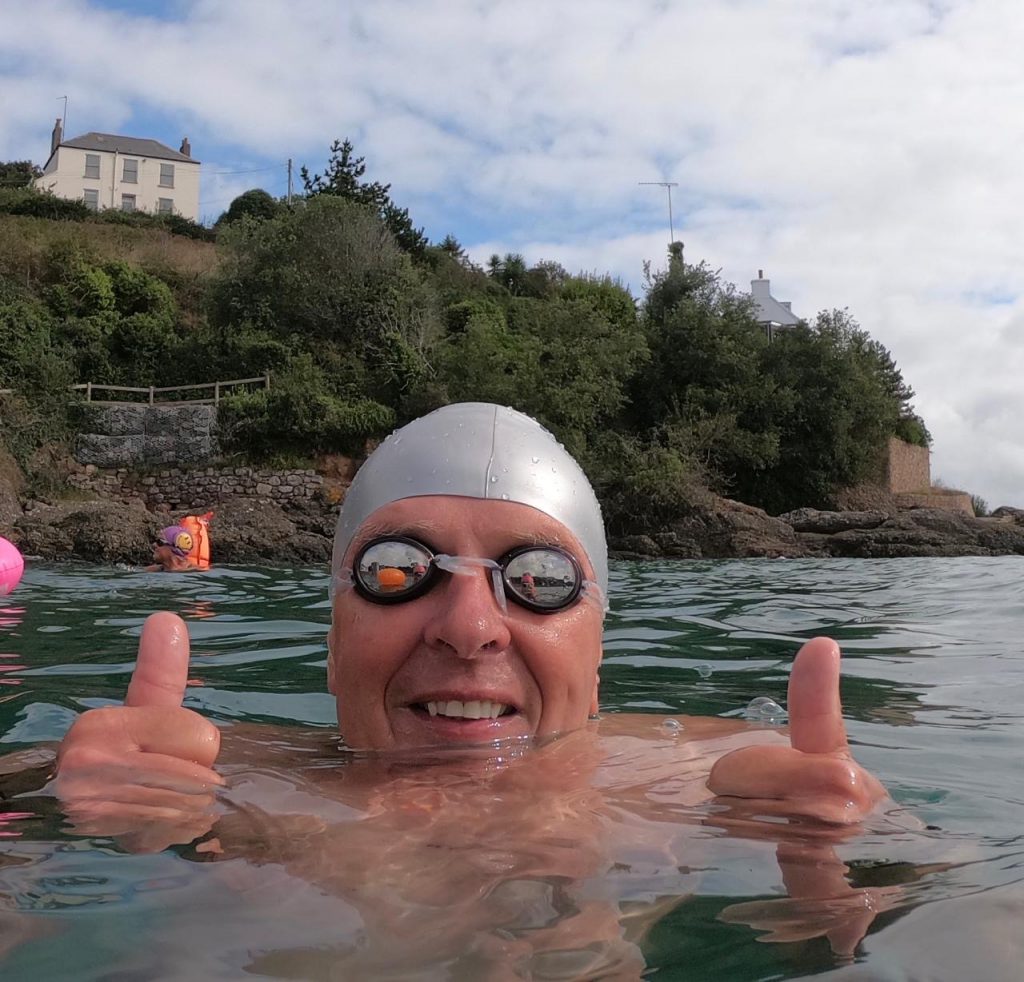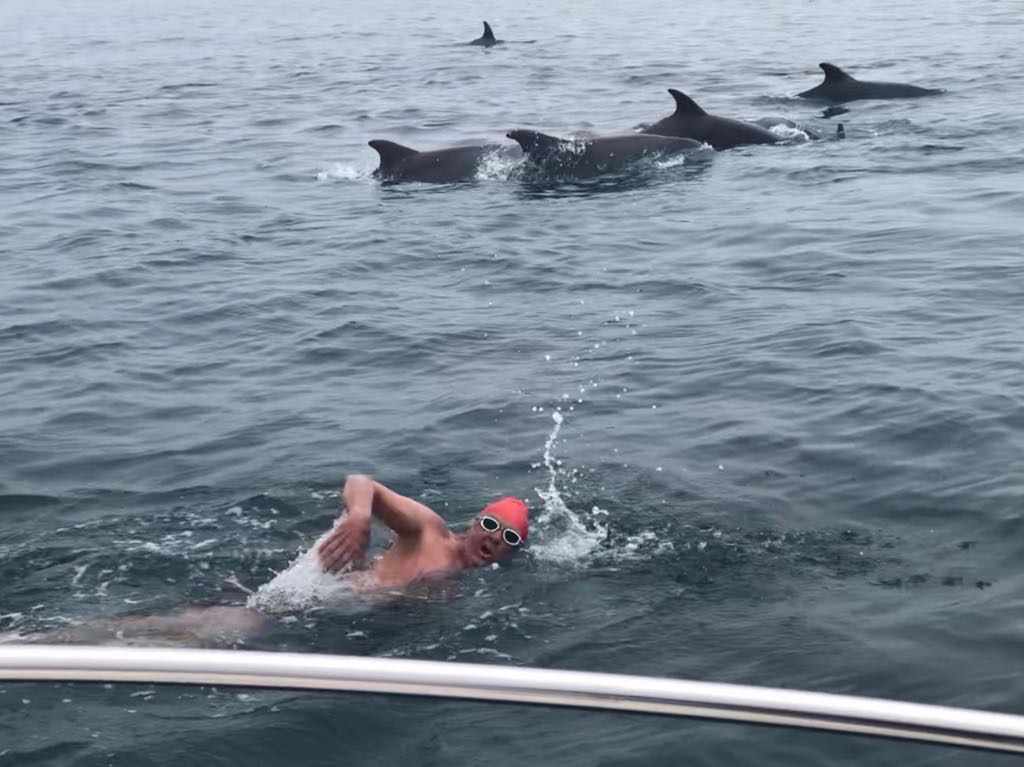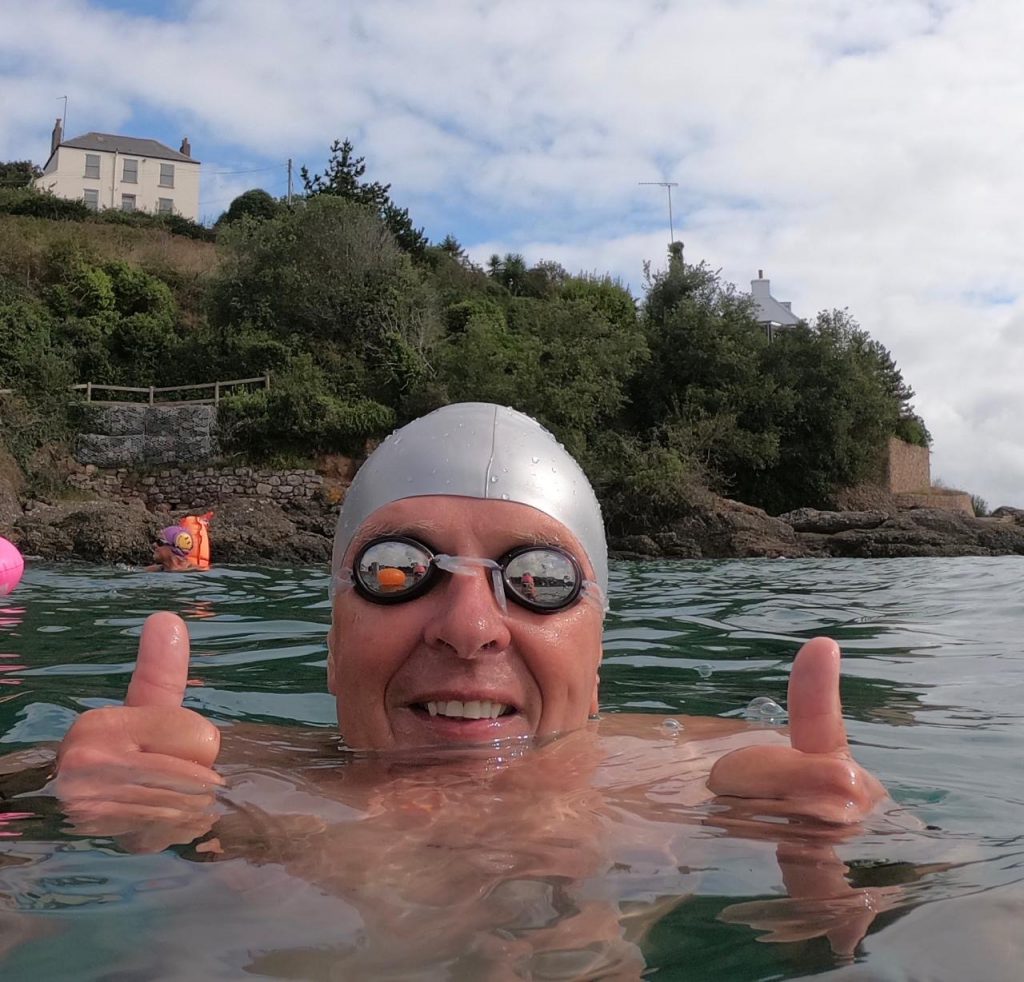To Relearn You First Have To Unlearn

Photo: Nicky Brown
Hey 2.4. How are you? I am good; thanks for thinking you would ask if we were one-to-one!
I am currently on the wonderful island of Jersey in the Channel Islands. I have been here for two weeks and have one week to go before I return to The Garden of England (that is the county of Kent in case you think I am boasting that I have a huge, well tended garden!).
On arrival here, I had to undergo a Covid test, which I passed (first test of any sort I have passed in about three decades!). It was an interesting procedure perhaps worthy of a separate blog. But, today, I want to write about the joy of open water swimming and particularly about relearning (deconstruct to reconstruct).
One of the first things I posted on this blog page was a piece entitled Open Water Swimming – Is It An Addiction Or An Affliction? There I talked about the joys of open water swimming, the pure, unfettered exhilarating feeling you get swimming outdoors, the polar opposite to the chemically controlled, claustrophobic, stifling environment in an indoor pool.
Before this trip, the last time I swam for real was in Mallorca last September with my partner, Chantelle. And, to be fair, that was exploring not training. But I haven’t stressed about not being able to swim since then, or during Boris Lock Down. I am lucky in that swimming is my second sport. Running is my first love and, even though hills are no longer my friends, I have had great fun running the trail these past, socially distanced months with my Bacon Butty Brigade running buddies.
I started open water swimming in 1992. After nearly 30 years, I have slightly overachieved on my original ambition and I have remained happily retired from long distance swimming events after my last Jersey to France swim in 2018. The photo below encapsulates in a freeze frame why that was such a great swim.

Photo: Chantelle Rose
The pod of around 15 dolphins joined us about four hours into the swim and stayed and played for two hours. They swam next to me, under me and left as suddenly as they appeared. It was a surreal and awesome experience and, under the tagline, “It can’t get better than this,” I retired on the spot. Well, I finished the swim first and then I retired! Having retired from the long swims, that made my decision, at the beginning of this year, to actually learn how to swim properly slightly odd and back to front but, typically, that is the norm in Cliffyworld.
All those years ago, in May 1992, instead of crashing, wide eyed and petrified onto Dover beach with the intention of swimming the Channel that year and, with nothing more than a Bronze certificate to my name, I should have engaged a coach and learnt a good, efficient technique and entered some smaller events first.
A two-year build up to a Channel solo would have been an intelligent approach. But, although that’s what I recommend to Channel aspirants now, it wasn’t the Cliffy way back then.
I have always likened my stroke to someone having the central heating turned up high on a cold winter’s day but with the windows wide open. There is an awful lot of power and energy but it’s escaping in all directions. Consequently, because I never sought to redress this early neglect, my swim technique has been ridiculed for my entire swimming career. I normally just smile and say, “I am comfortable with my achievements.”
Secretly, though, I have always wanted to be a better swimmer, to be able to swim more efficiently and with good technique. But I have been inhibited by a basic learning flaw I discovered in myself when I joined Black Lion Swimming Club in Gillingham in 1993. My problem is that I have always found it difficult to assimilate verbal command from club coaches standing vertical trying to explain to me what I have to do horizontal.
Apparently, this inability to learn conventionally could be because I am a Kinesthetic learner, which means I learn differently from others – more tactile, less reading, less convention, more doing. I wish that had been identified when I was a lad. I might have left school with more than one O Level and a clutch of CSEs!!
A lot of learning emanates from desire plus timing (a clear goal in equilibrium with it being the right time and, equally as important, the right mind set). In wanting to relearn how to swim, the desire was that I wasn’t planning any big swims so, without that pressure, I could take time out to deconstruct to reconstruct. Timing was that, when I was thinking of relearning how to swim, I heard about Tracey Baumann at SwimMastery (www.swimmastery.online).
Tracey came highly recommended by my friend, Hayley Brant, of Team Comet (d’ya geddit? Hayley’s Comet!!). I was one of Hayley’s crew on her successful solo Channel swim last year and I was very impressed with how she maintained a metronomic form throughout the swim. There was no degradation at all and I wanted to know how she did it. I asked her about it afterwards and she told me about Tracey and the techniques she learnt from her.
Tracey has 25 fully trained SwimMastery coaches in 7 countries and, without that pressure of a looming swim, and nearly 3 decades after the horse had bolted, I eagerly jumped into her Endless pool willing and able.
I really enjoyed the two sessions I had with Tracey. The video analysis and comparisons were particularly attuned to my way of learning. One of the most impressive bits in one of these sessions was when her colleague, and fellow coach, Pam, got in and swam while I watched. The speed was set at around 2 minutes for a 100 metres and I watched as Pam swam in a most relaxed, seemingly effortless way. Holding my breath underwater as I watched her, I compared it to my somewhat wayward thrashing about (I was looking for a kinder word than thrashing but couldn’t think of one!). I wanted some of that! Then Tracey cranked the speed up to 1 minute 30 seconds pace and, remarkably to this new convert, Pam seemed to be swimming just the same, just as relaxed and with no more effort than at the slower speed.
I came away brimming with intent and with lots of ideas and drills to practice and eager for the next session. Then BLD stopped play and practice and I started to forget that I used to swim (so glad I had my running).
But now I am in Jersey with lots of bays to swim in and practice. Aside from practicing the drills, I was also determined to find the love of the brine again on this trip and there are few better places to swim open water in than Jersey.
The Three (Could Be Four) Stages Of Entering The Water
I have always admired, been slightly envious of and determined never to imitate those who dive straight into freezing (relative term) water. OK, at the start of an actual event you normally have to do that but adrenalin wins the day then and you just get on with it. But, on a training swim, that’s not me.
For me, entering open water is a three-stage process. Or four if you include taking an inordinate amount of time getting ready and using every stalling tactic known to man.
Stage one is discarding your flip-flops or Crocs and walking in up to your ankles. On sand this isn’t an issue. On a pebble beach it’s a masochistic pain fest.
Ankle deep is an interesting experience for the newbie or veteran. Even though you know it will be cold there is still that tiny shudder, that frisson of surprise and realisation that, in my case, there is still another five foot nine inches of quivering, reluctant flesh to immerse.
Stage two is the half immersion. Now, I’m good up to the waistband of my Speedos. In fact, entry up to waistband is a bit of a specialism of mine. After that I’m a silent screamer, a tiptoeing Canutian wimp trying to push back the waves. I can stand for minutes in this half immersed position – I think my personal record is about ten minutes before I started to swim.
I should say I am talking about sea temperatures of 9C up to about 19C. From 20C upwards, frankly I should be able to man-up and stride in with a, “Yes, nothing to see here. I do it like this all the time, whatever the temperature.” (#Idon’t)
Stage three is a complete immersion followed by forward movement with intent. It’s very important that this stage isn’t accompanied by screams. Stifled, barely audible screams are much preferred. Complete immersion is preceded by sharp intakes and expulsions of breath.
You know what it is? It’s immersing the core, the engine, the heart and lungs. And then it’s putting your head in. In water that’s 9 to, say, 12C it’s that inevitable ‘Ice Cream’ headache. It’s just the pants. Not little pants. Big pants. Bridget Jones pants. Oh, the pain. Oh the memory.
In those low temperatures you have to deal with claw hands too and trying to spell your name in your head with less than two mistakes. But, then something miraculous happens. You get a rhythm, a momentum, which, even with my aforementioned, but I’m working on it, flawed stroke, is exhilarating and cathartic and life enhancing.
That tremulous, I don’t like this bit, entry is but a memory now and gives way to a wonderful feeling of well being and oneness. It’s what kept me coming back year after year (and, of course, to drink from the everlasting cup of kindness and camaraderie that permeates our sport). I feel I want to share this love for open water swimming and scatter it like autumn leaves in a force seven gale.
Oh, maybe I just did. Take care, stay safe, swim safe.


Hahaha! I laughed a lot at your descriptions of the stages and I can relate in so many ways. I’m so glad you and Tracey Baumann found each other. (3, is the magic number … #justsayin’…)
Love love love open water swimming, with like minded people who are just as mad as me looking for the andrenalin rush, especially on a cold winters day! Nothing quite beats it!!!
Thank you Cliff (as Billie says, once Mary or Joseph is in there’s no going back!!!)
I couldn’t quite believe my eyes when I saw Tracey’s post! She’s such an talented coach, I’m glad you’re enjoying being back in the water.
Thanks for all your help and encouragement on the long swims in Mallorca last summer!
beautiful